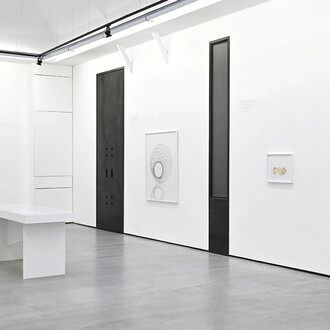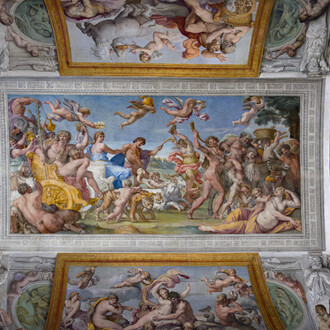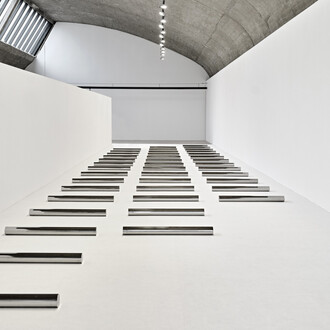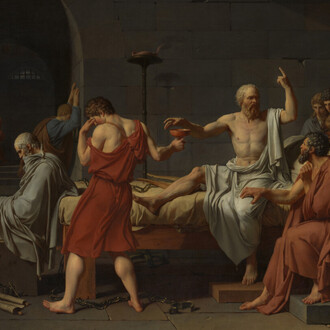Graham Wilson’s second solo exhibition at the gallery, Splittin At The Seams...; is a rigorous short survey of the artist’s ever evolving painting practice, delving in experimentation with shape, color, process, and exactly what these aspects mean on a larger scale in relation to history, both popular and personal. The exhibition takes a deep dive into the psychological conditions of growing up in modern America, the human relationship to objects, furthermore the consequences and repercussions of said objects, in their manufacturing process as well as their accession. In this presentation of work, the artist gives us an intimate look into his life, and art’s function in it as Wilson weaves, both figuratively and literally, through the inner and outer workings of his modus operandi.
Perhaps the most pertinent aspect of this exhibition was the artist’s production method, choosing to recall the bulk of his “unsold” works from galleries which represent him, further breaking them down, a gesture which in itself nods to the drastic need most of all for conscious choices moving forward in industry, as well as his private need for constant exploration.Comparable to a science experiment, Wilson sets up an operation using X set of materials, pushing their functions physically as well as lacing them with metaphoric connotations. These probes result in a multitude of objects and various displays, in which the artist examines a situation and finds its different outcomes. A situation that rings similar to our broader emergency at hand, one that calls for creative solutions for materials alien to our habitat, but which now exist in staggering amounts. These factors, palpably manifested in the corner installation Downsizing, a riff on the 2017 movie, where people undergo a process in which scientists shrink them down to miniature size in order to offset the consumption of natural resources.
Wilson’s painting practice gradually gets smaller as stretchers and frames stuffed in a shopping cart, seemingly push the materials through drain-like tubes until small molded rocklike sculptures, deemed “Condensed Paintings” are spit out and placed on found chintzy pedestals. The decimated artworks, once his signature DBL series (now culminated), or “quilts” previously with “all over” compositions, now completely dismantled, Wilson hoards all the bits and pieces in an obsessive manner, playing out some sort of speculative fiction doomsday scenario where he is somehow confined to his studio with only the means at hand. Fragments of twine form into sculpture, canvas thread tumbleweeds accrue, cling together and morph into wall and floor entities, paint scrapings leak out of the wall as if they are decaying from the inside, while chunks of paintings are chipped down and composed into precise arrangements of colorful blocks, pure playful scores that simply render directional movements, up, down, angles, rings, checkers, etc.
It seems the artist went to the thresholds, and has now returned to a place of measure, of archetypes, calculating his surroundings with a conceptual outlook. Clearly evident in the piece, Homonyms, a work that features four round objects. Two works previously shown, a ball of piecemealed twine, Trying To Hold It Together With Nothing But A Bunch Of Loose Ends, 2016, and Wilson’s Self Portrait At 26, a clown nose which was simply hung on a blank wall at his actual nose height in his 2015 show in Milan. They join one of the artists new “Hairballs”, and a spraypainted wall circle overlooking the spheres, which simply reads “Cut Here” with an arrow pointing to the circle. Here Wilson aims to show the interconnectedness of all things, purposely misusing the word “Homonym” in order to reveal the notion that each person sees everything differently, according to their own viewpoint, where things that you identify with are inherited by your past, your upbringing, environment, and surrounding culture. The artist here, using the simple two-word text to suggest the breaking of this cyclical arrangement, a step towards freedom.
The battle of creation and destruction a persistent characteristic in his work to date, Wilson this time takes it a step further, disassociating himself from sentiment or attachment to his creations. Relinquishing control of the postulation of “my” in regards to his work, of the egoic mind conditioned by the past. This twofold priming, containing content and structure, starts as an infant, where upon learning a group of sounds that become your name, a child begins to equate a word, with who he, she, or they are. Soon after, they learn the word “I”, then “me”, “my”, and “mine”. This begins an identification with objects, where things become part of the person’s sense of self.
The artist battles with relinquishing these inclinations in works such as idem, a self-portrait style voodoo doll being poked and pricked by the artist’s main tool, his sewing needles, or in the installation containing, Mucho Trabajo, a video work that pairs with Dead Pan Club…(I Think You Missed The Joke), a work from Wilson’s solo presentation at ARCO Madrid in 2016, where upon the artist was interviewed by the news channel “tele Cinco” about his work. Wilson here clearly mocking himself, as he cuts and staggers the video to simply repeat in bad Spanish, “I am the artist Graham Wilson, this is my work here.”
The video briefly shows a picture of the work it now sits beside, representing a disconnect from reality. Wilson’s links this concept to the science of “flashbacks”, recalling the genesis of his own mental health struggles, being diagnosed Bipolar I several months after the said interview.
Studies show that when patients relive flashbacks the left area of their brain responsible for rational thinking slows down, causing difficulty in differentiating what’s real and what’s not. Wilson continues his reverie in the remaining works, as if he is not only confined by physical space in this trial, but a mental one as well, reminiscing on the tumultuous collective history of his peer group, and the generations that follow, as he witnesses the fallout of these circumstances in real time. Research by the Centers for Disease Control and Prevention has shown that one in five Americans was sexually molested as a child; one in four was beaten by a parent to the point of a mark being left on their body; and one in three couples engages in physical violence. A quarter of us grew up with alcoholic relatives, and one out of eight witnessed their mother being beaten or hit.
In Stuck In The Schema, a pun relating the the “schema”, which in psychology describes a pattern of thought or behavior that organizes categories of information and the relationships among them. The artist here presents a bedroom like display, however the bed itself pinned against the wall, in it’s position providing no possibility for rest, as the air mattress breathes in and out as an entity itself. The artist here commenting on the vivid effects of PTSD, such an insomnia. Near this set up, viewers come across What Would Meek Do?, a work referential to his childhood, in the 90s when the phrase "What Would Jesus Do?", often abbreviated to WWJD, became popular particularly in the United States. After the fall of the church, directly revealed in the work, Irish Catholic, a set of three paintings which Wilson hang crucifixion style, paint chips piling under the middle work, as if it is decaying as it hangs. Generationally left with few role models, Wilson likens cult figures like Meek Mill to Jesus for his suffering through the criminal justice system, where everyday children are locked up and forgotten about, their lives pulled from them before even beginning.
This concept, pointedly graphic in the work, Timeout, where a decrepit, patched up teddy bear, Self Portrait At 31, clings looking out through bars of a Windsor chair facing the corner. Spray painted on the wall behind, the words “Count to 10000000000”, originally meant to say, “Count to 100”, in traditional “time out” fashion, the 0’s trail on forever giving tangible weight to the length of time Americans have waited for real change.
In what is assuredly an unhinged, yet inspired effort, presented on the occasion of FIAC, where people of the world will convene for their mutual interest in art, Wilson hopes to alter the televised version of his home country, and instead express his peer’s convictions for empathy, evolution, and equality.
















